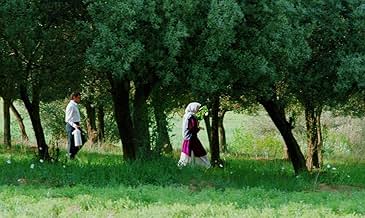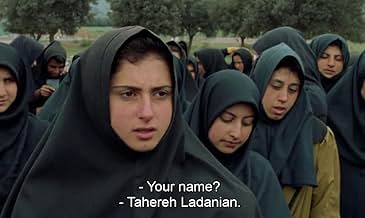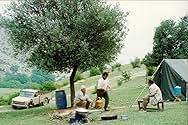NOTE IMDb
7,7/10
11 k
MA NOTE
Ajouter une intrigue dans votre langueA depiction of the off-screen relationship between the actors who play the newlyweds in the film Et la vie continue (1992).A depiction of the off-screen relationship between the actors who play the newlyweds in the film Et la vie continue (1992).A depiction of the off-screen relationship between the actors who play the newlyweds in the film Et la vie continue (1992).
- Réalisation
- Scénario
- Casting principal
- Récompenses
- 5 victoires et 6 nominations au total
Ostadvali Babaei
- Teacher
- (as Astadouli Babani)
Nosrat Bagheri
- Achiz
- (as Nasret Betri)
Khodabakhsh Defaei
- Teacher
- (as Kheda Barech Defai)
Hossein Jafarian
- Hossein
- (non crédité)
Jafar Panahi
- Panahi
- (non crédité)
Avis à la une
Abbas Kiarostami's movies along the likes of Mr.Yasujiro Ozu and Edward yang are just like a calm stream of river that keeps on flowing eternally providing neverending relief, life and peace.
If you have enough patience and interest these movies will never bore you, and you could even watch them for many hours if their runtime was even mkre, but at last provide you with a feelgood experience as their movies are so close to our everyday reality that they feel like the stories in them could happen anywhere around us in any part of the world.
Third part of Abbas kiarostami's Koker trilogy providing behind the scenes outlook to "And life goes on...(1992)", almost feels like a complete story in itself about 2 youngsters trying hard to find eachother in all the tension surrounding, after the 1990 earthquake.
The minimalistic director Abbas kiarostami does wonders in almost his every movie that many action directors could not, a true genius.
First thing: this is the third part in a trilogy. You really need to see "Where is the Friend's House" & "And Life Goes On" first if you want to fully understand this. In short, this is a film about a man making a film of his own journey in search of actors in a film he made earlier. Once you know that, it's not in the least slow or simple, it's a hall of mirrors, as another commentator put it. Frames within frames within frames.
Second thing: Jean-Luc Godard praised Kiarostami's early films, but then felt he'd become too influenced by the international art movie tradition. I don't know if this is a film he liked or disliked, but it sure has a lot of Godard's influence in it - from the director interviewing sundry characters through the conflation of documentary and fiction elements to the use of music, it's like Godard crossed with Satyajit Ray. Not that that's a bad thing.
I don't know if Kiarostami is as original or as striking as some maintain - in many ways this is "Day for Night" transplanted to the Iranian countryside - but it's very watchable, often very funny and the landscape is beautiful.
There also seems to be (in the Iranian context) a subversive subtext to these films. Tradition is held up as hidebound and stupid (the adults in "Where is the Friend's House", the grandmother in this film) while the young are seen improvising their own lives and creating hope in the face of catastrophe. I can't imagine that's too popular with the mullahs, and indeed it seems that Kiarostami has been unable to get a film released in Iran in a decade.
Well worth a view, and it may even inspire you to get out into the world with a digital video camera, but do see the other films (and probably also "Homework") first.
Second thing: Jean-Luc Godard praised Kiarostami's early films, but then felt he'd become too influenced by the international art movie tradition. I don't know if this is a film he liked or disliked, but it sure has a lot of Godard's influence in it - from the director interviewing sundry characters through the conflation of documentary and fiction elements to the use of music, it's like Godard crossed with Satyajit Ray. Not that that's a bad thing.
I don't know if Kiarostami is as original or as striking as some maintain - in many ways this is "Day for Night" transplanted to the Iranian countryside - but it's very watchable, often very funny and the landscape is beautiful.
There also seems to be (in the Iranian context) a subversive subtext to these films. Tradition is held up as hidebound and stupid (the adults in "Where is the Friend's House", the grandmother in this film) while the young are seen improvising their own lives and creating hope in the face of catastrophe. I can't imagine that's too popular with the mullahs, and indeed it seems that Kiarostami has been unable to get a film released in Iran in a decade.
Well worth a view, and it may even inspire you to get out into the world with a digital video camera, but do see the other films (and probably also "Homework") first.
Through the Olive Trees is a great example of how neo-realistic techniques can show realism in film making. One personal criticism would be the music, but that is purely personal, and takes nothing away from the film. A masterpeice.
This epoch-making poem opens with a film crew trying to cast for a movie in a provincial village, in the aftermath of A DEVASTATING EARTHQUAKE which has claimed many, many lives. We then are shown that the remaining people are trying to rebuild their lives, picking up bits and pieces of the past, but with an eye to the future.example of these people are the boy and the girl who are selected to play the protagonists of the melodrama to be made. The crew's interest interest in these people is limited to their role and usefulness for director's vision of the film, and no more. But-and this is a crucial BUT-the boy and the girl have their own agenda, and don't care very much for the screenplay dictated by the director (for instance repeated takes of the tea-serving scene): The girl wants to wear colorful and jolly dress, and the boy wants to be able to love her. Eventually, the boy follws the girl into the magnificent ending shot of the expanse of the olive groves, and into the ubncertain but potentially hopeful future. Will life, love and color be able to vanquish darkness and death? Will the boy and the girl find the courage and and power to fire the crew, the director, the casting agent , down to the ticket-vendor and become subjects of their own life and destiny? ... This is to be continued.........
Found this film to easily engage my heart without burdening my head with too much technique. Funny, sad, the two sides of the ever encompassing cinema coin. An seemingly effortless exploration of the relationships of men and women, tradition and experience, the old and the somewhat new. And what a beautiful rhythmic last sequence, one of the best of all my moviegoing history.
Le saviez-vous
- AnecdotesThe first film in which Abbas Kiarostami has hired a professional actor (Mohamad Ali Keshavarz who plays the director of the film-within-the-film).
- ConnexionsFeatured in Cinema Iran (2005)
Meilleurs choix
Connectez-vous pour évaluer et suivre la liste de favoris afin de recevoir des recommandations personnalisées
- How long is Through the Olive Trees?Alimenté par Alexa
Détails
- Date de sortie
- Pays d’origine
- Site officiel
- Langue
- Aussi connu sous le nom de
- Through the Olive Trees
- Lieux de tournage
- Sociétés de production
- Voir plus de crédits d'entreprise sur IMDbPro
Box-office
- Montant brut aux États-Unis et au Canada
- 40 300 $US
Contribuer à cette page
Suggérer une modification ou ajouter du contenu manquant






















